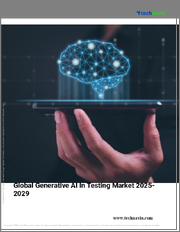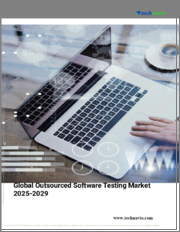
|
시장보고서
상품코드
1801006
퓨어 플레이 소프트웨어 테스트 시장 보고서 : 배포 유형, 조직 규모, 최종 사용 산업, 지역별(2025-2033년)Pure Play Software Testing Market Report by Deployment Type, Organization Size, End Use Industry, and Region 2025-2033 |
||||||
세계의 퓨어 플레이 소프트웨어 테스트 시장 규모는 2024년에 148억 달러에 달했습니다. 향후, IMARC Group은 2033년에는 331억 달러에 달하며, 2025-2033년의 성장률(CAGR)은 8.87%에 달할 것으로 예측하고 있습니다.
퓨어플레이 소프트웨어는 단일 산업을 위해 제품을 제조하고 인터넷을 통해 제품을 소매하는 조직이 개발한 컴퓨터 기반 제품을 말합니다. 퓨어플레이 소프트웨어 테스트는 제품 개발자가 정식 출시 전에 소프트웨어를 최적화하고 버그를 수정하기 위해 채택합니다. 테스트 서비스 프로바이더는 혁신적인 툴와 첨단 솔루션을 사용하여 프로젝트 기반 테스트, 위험 기반 테스트, 관리형 클라우드 테스트를 수행합니다. 이러한 테스트는 관리형 멀티 플랫폼 테스트 환경에서 수행되며, 엔드 투 엔드 소프트웨어를 관리하고 고품질 소프트웨어를 개발합니다. 또한 프로세스 오케스트레이션 엔진, 인간 대 인간 워크플로우, 모니터링 및 분석 기능, 오프라인 시뮬레이션, 시스템 간 통합 등을 제공합니다.
세계 정보기술(IT) 산업의 괄목할 만한 성장과 함께 디지털화가 진행되고 있는 것은 시장 전망을 밝게 하는 중요한 요인 중 하나입니다. 또한 중소기업 및 대기업의 아웃소싱 서비스, 소프트웨어, 웹 기반 플랫폼에 대한 수요 증가도 시장 성장을 가속하고 있습니다. 은행, 금융서비스 및 보험(BFSI), 정보기술(IT), 통신, 소매 등의 업계는 디지털 툴와 순수 소프트웨어를 사용하여 업무를 확장하고 원격 근무를 촉진하고 있습니다. 또한 사물인터넷(IoT), 인공지능(AI), 머신러닝(ML) 솔루션과 소프트웨어 테스트 모듈의 통합 등 다양한 기술 발전도 성장을 가속하는 요인으로 작용하고 있습니다. 독립적인 퓨어플레이 소프트웨어 테스팅 서비스 프로바이더는 이러한 혁신적인 기술을 활용하여 원활하고 오류 없는 용도과 소프트웨어를 제작하고 있습니다.
이 보고서에서 다룬 주요 질문
- 세계 퓨어플레이 소프트웨어 테스트 시장은 지금까지 어떻게 성장해왔고, 앞으로 어떻게 성장하는가?
- COVID-19가 세계의 퓨어 플레이 소프트웨어 테스트 시장에 미치는 영향은?
- 주요 지역 시장은?
- 전개 유형에 따른 시장 분석은?
- 조직 규모별 시장 현황은?
- 최종 사용 산업별 시장 분석은?
- 산업 밸류체인의 다양한 단계는?
- 업계의 주요 촉진요인과 과제는?
- 세계 퓨어플레이 소프트웨어 테스트 시장의 구조와 주요 기업은?
- 업계내 경쟁은 어느 정도인가?
목차
제1장 서문
제2장 조사 범위와 조사 방법
- 조사의 목적
- 이해관계자
- 데이터 소스
- 1차 정보
- 2차 정보
- 시장 추정
- 보텀업 어프로치
- 톱다운 어프로치
- 조사 방법
제3장 개요
제4장 서론
제5장 세계의 퓨어 플레이 소프트웨어 테스트 시장
- 시장 개요
- 시장 실적
- COVID-19의 영향
- 시장 예측
제6장 시장 내역 : 배포 유형별
- 클라우드 기반
- 온프레미스
제7장 시장 내역 : 조직 규모별
- 중소기업
- 대기업
제8장 시장 내역 : 최종 사용 산업별
- BFSI
- IT·통신
- 소매업과 E-Commerce
- 기타
제9장 시장 내역 : 지역별
- 북미
- 미국
- 캐나다
- 아시아태평양
- 중국
- 일본
- 인도
- 한국
- 호주
- 인도네시아
- 기타
- 유럽
- 독일
- 프랑스
- 영국
- 이탈리아
- 스페인
- 러시아
- 기타
- 라틴아메리카
- 브라질
- 멕시코
- 기타
- 중동 및 아프리카
제10장 SWOT 분석
제11장 밸류체인 분석
제12장 Porter's Five Forces 분석
제13장 가격 분석
제14장 경쟁 구도
- 시장 구조
- 주요 기업
- 주요 기업의 개요
- Acutest Ltd.
- Cigniti Technologies Limited
- DXC Technology Company
- imbus AG
- inspearit
- Planit Test Management Solutions Pty. Ltd.
- QA InfoTech
- Qualitest Group
- Trigent Software Inc.
- ZenQ
The global pure play software testing market size reached USD 14.8 Billion in 2024. Looking forward, IMARC Group expects the market to reach USD 33.1 Billion by 2033, exhibiting a growth rate (CAGR) of 8.87% during 2025-2033.
A pure-play software refers to a computer-based product developed by an organization that is exclusively manufacturing products for a single industry and retailing their products through the internet. Pure play software testing is adopted by product developers to optimize the software and fix bugs before the official launch. Testing service providers use innovative tools and advanced solutions for the project- and risk-based testing and managed crowd testing. They are conducted in a controlled multi-platform testing environment to manage end-to-end software and develop high-quality software. They also offer process orchestration engine, human-to-human workflow, monitoring and analysis capabilities, offline simulation and system-to-system integration.
Increasing digitization, along with significant growth in the information technology (IT) industry across the globe, represents one of the key factors creating a positive outlook for the market. Furthermore, the increasing demand for outsourced services, software, and web-based platforms by small, medium and large-sized enterprises, is also driving the market growth. The industries, such as banking, financial services and insurance (BFSI), information technology (IT), telecommunication and retail, are using digital tools and pure-play software to expand their operations and facilitate remote working. Additionally, various technological advancements, such as the integration of the Internet of Things (IoT), artificial intelligence (AI) and machine learning (ML) solutions with the software testing modules, are acting as other growth-inducing factors. Independent pure-play software testing service providers use these innovative technologies to produce seamless and error-free applications and software.
Key Market Segmentation:
Breakup by Deployment Type:
- Cloud-Based
- On-Premises
Breakup by Organization Size:
- Small and Medium Enterprises
- Large Enterprises
Breakup by End Use Industry:
- BFSI
- IT and Telecommunication
- Retail and E-Commerce
- Others
Breakup by Region:
- North America
- United States
- Canada
- Asia-Pacific
- China
- Japan
- India
- South Korea
- Australia
- Indonesia
- Others
- Europe
- Germany
- France
- United Kingdom
- Italy
- Spain
- Russia
- Others
- Latin America
- Brazil
- Mexico
- Others
- Middle East and Africa
Competitive Landscape:
The competitive landscape of the industry has also been examined along with the profiles of the key players being Acutest Ltd., Cigniti Technologies Limited, DXC Technology Company, imbus AG, inspearit, Planit Test Management Solutions Pty. Ltd., QA InfoTech, Qualitest Group, Trigent Software Inc. and ZenQ.
Key Questions Answered in This Report:
- How has the global pure play software testing market performed so far and how will it perform in the coming years?
- What has been the impact of COVID-19 on the global pure play software testing market?
- What are the key regional markets?
- What is the breakup of the market based on the deployment type?
- What is the breakup of the market based on the organization size?
- What is the breakup of the market based on the end use industry?
- What are the various stages in the value chain of the industry?
- What are the key driving factors and challenges in the industry?
- What is the structure of the global pure play software testing market and who are the key players?
- What is the degree of competition in the industry?
Table of Contents
1 Preface
2 Scope and Methodology
- 2.1 Objectives of the Study
- 2.2 Stakeholders
- 2.3 Data Sources
- 2.3.1 Primary Sources
- 2.3.2 Secondary Sources
- 2.4 Market Estimation
- 2.4.1 Bottom-Up Approach
- 2.4.2 Top-Down Approach
- 2.5 Forecasting Methodology
3 Executive Summary
4 Introduction
- 4.1 Overview
- 4.2 Key Industry Trends
5 Global Pure Play Software Testing Market
- 5.1 Market Overview
- 5.2 Market Performance
- 5.3 Impact of COVID-19
- 5.4 Market Forecast
6 Market Breakup by Deployment Type
- 6.1 Cloud-Based
- 6.1.1 Market Trends
- 6.1.2 Market Forecast
- 6.2 On-Premises
- 6.2.1 Market Trends
- 6.2.2 Market Forecast
7 Market Breakup by Organization Size
- 7.1 Small and Medium Enterprises
- 7.1.1 Market Trends
- 7.1.2 Market Forecast
- 7.2 Large Enterprises
- 7.2.1 Market Trends
- 7.2.2 Market Forecast
8 Market Breakup by End Use Industry
- 8.1 BFSI
- 8.1.1 Market Trends
- 8.1.2 Market Forecast
- 8.2 IT and Telecommunication
- 8.2.1 Market Trends
- 8.2.2 Market Forecast
- 8.3 Retail and E-Commerce
- 8.3.1 Market Trends
- 8.3.2 Market Forecast
- 8.4 Others
- 8.4.1 Market Trends
- 8.4.2 Market Forecast
9 Market Breakup by Region
- 9.1 North America
- 9.1.1 United States
- 9.1.1.1 Market Trends
- 9.1.1.2 Market Forecast
- 9.1.2 Canada
- 9.1.2.1 Market Trends
- 9.1.2.2 Market Forecast
- 9.1.1 United States
- 9.2 Asia-Pacific
- 9.2.1 China
- 9.2.1.1 Market Trends
- 9.2.1.2 Market Forecast
- 9.2.2 Japan
- 9.2.2.1 Market Trends
- 9.2.2.2 Market Forecast
- 9.2.3 India
- 9.2.3.1 Market Trends
- 9.2.3.2 Market Forecast
- 9.2.4 South Korea
- 9.2.4.1 Market Trends
- 9.2.4.2 Market Forecast
- 9.2.5 Australia
- 9.2.5.1 Market Trends
- 9.2.5.2 Market Forecast
- 9.2.6 Indonesia
- 9.2.6.1 Market Trends
- 9.2.6.2 Market Forecast
- 9.2.7 Others
- 9.2.7.1 Market Trends
- 9.2.7.2 Market Forecast
- 9.2.1 China
- 9.3 Europe
- 9.3.1 Germany
- 9.3.1.1 Market Trends
- 9.3.1.2 Market Forecast
- 9.3.2 France
- 9.3.2.1 Market Trends
- 9.3.2.2 Market Forecast
- 9.3.3 United Kingdom
- 9.3.3.1 Market Trends
- 9.3.3.2 Market Forecast
- 9.3.4 Italy
- 9.3.4.1 Market Trends
- 9.3.4.2 Market Forecast
- 9.3.5 Spain
- 9.3.5.1 Market Trends
- 9.3.5.2 Market Forecast
- 9.3.6 Russia
- 9.3.6.1 Market Trends
- 9.3.6.2 Market Forecast
- 9.3.7 Others
- 9.3.7.1 Market Trends
- 9.3.7.2 Market Forecast
- 9.3.1 Germany
- 9.4 Latin America
- 9.4.1 Brazil
- 9.4.1.1 Market Trends
- 9.4.1.2 Market Forecast
- 9.4.2 Mexico
- 9.4.2.1 Market Trends
- 9.4.2.2 Market Forecast
- 9.4.3 Others
- 9.4.3.1 Market Trends
- 9.4.3.2 Market Forecast
- 9.4.1 Brazil
- 9.5 Middle East and Africa
- 9.5.1 Market Trends
- 9.5.2 Market Breakup by Country
- 9.5.3 Market Forecast
10 SWOT Analysis
- 10.1 Overview
- 10.2 Strengths
- 10.3 Weaknesses
- 10.4 Opportunities
- 10.5 Threats
11 Value Chain Analysis
12 Porters Five Forces Analysis
- 12.1 Overview
- 12.2 Bargaining Power of Buyers
- 12.3 Bargaining Power of Suppliers
- 12.4 Degree of Competition
- 12.5 Threat of New Entrants
- 12.6 Threat of Substitutes
13 Price Analysis
14 Competitive Landscape
- 14.1 Market Structure
- 14.2 Key Players
- 14.3 Profiles of Key Players
- 14.3.1 Acutest Ltd.
- 14.3.1.1 Company Overview
- 14.3.1.2 Product Portfolio
- 14.3.1.3 Financials
- 14.3.1.4 SWOT Analysis
- 14.3.2 Cigniti Technologies Limited
- 14.3.2.1 Company Overview
- 14.3.2.2 Product Portfolio
- 14.3.2.3 Financials
- 14.3.2.4 SWOT Analysis
- 14.3.3 DXC Technology Company
- 14.3.3.1 Company Overview
- 14.3.3.2 Product Portfolio
- 14.3.3.3 SWOT Analysis
- 14.3.4 imbus AG
- 14.3.4.1 Company Overview
- 14.3.4.2 Product Portfolio
- 14.3.4.3 Financials
- 14.3.4.4 SWOT Analysis
- 14.3.5 inspearit
- 14.3.5.1 Company Overview
- 14.3.5.2 Product Portfolio
- 14.3.5.3 Financials
- 14.3.5.4 SWOT Analysis
- 14.3.6 Planit Test Management Solutions Pty. Ltd.
- 14.3.6.1 Company Overview
- 14.3.6.2 Product Portfolio
- 14.3.6.3 Financials
- 14.3.7 QA InfoTech
- 14.3.7.1 Company Overview
- 14.3.7.2 Product Portfolio
- 14.3.7.3 Financials
- 14.3.8 Qualitest Group
- 14.3.8.1 Company Overview
- 14.3.8.2 Product Portfolio
- 14.3.8.3 Financials
- 14.3.9 Trigent Software Inc.
- 14.3.9.1 Company Overview
- 14.3.9.2 Product Portfolio
- 14.3.9.3 Financials
- 14.3.10 ZenQ
- 14.3.10.1 Company Overview
- 14.3.10.2 Product Portfolio
- 14.3.10.3 Financials
- 14.3.1 Acutest Ltd.



















